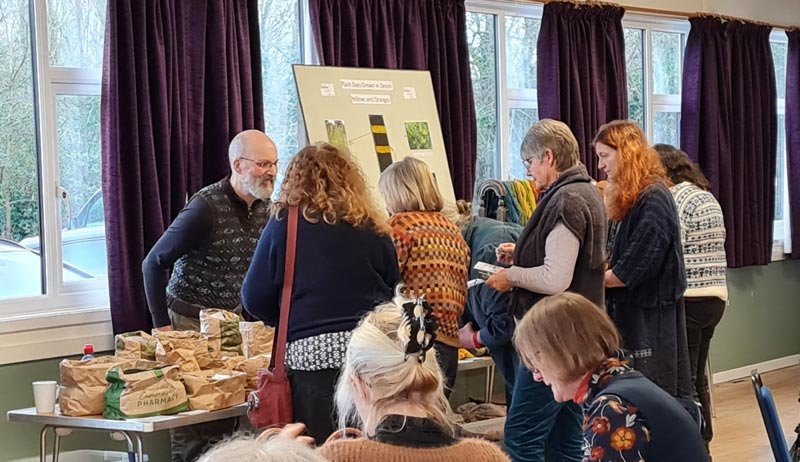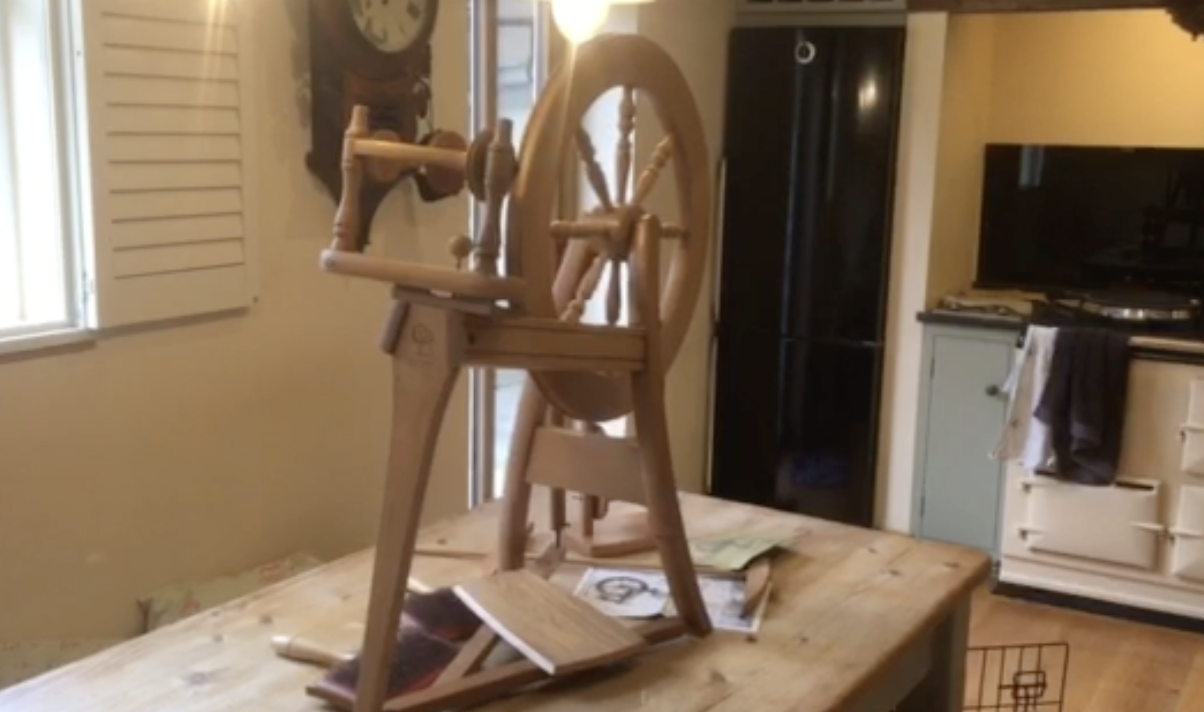March 2024 newsletter
Contents
Chairperson's message
Change is in the air! We’re delighted to welcome our new chair, Mandy Stead. Below you can find Mandy’s first chairperson’s message, alongside a note from Marilyn.
Message from Mandy:
I would like to say a big thank you for voting me in and to the committee for supporting me
One of the big themes I would like to promote is the notice board. So please read and direct any queries via the secretary when not at the Guild days.
The library is now being coordinated by Sarah Basham and Sue Luty Wells. With a rota for help. With names already added. So thank you. Kitchen is now being organised by Kathy Wright. Also with a rota with names added. So thank you. Outside events are now being coordinated by Lesley Took. I have a list of volunteer demonstrators. Thank you More can be added. Equipment is in the process of being reorganised by Sue Latimer. More details to follow and on the notice board. Car share was raised and do add your name and details to the list if you can. And anyone who you know who might indeed need a lift. So this can be coordinated. Do get in touch if you can do this. Thank you to those who have offered to help meet and greet and welcome new and visiting members
This all helps the smooth running of the Guild
Many thanks, Mandy stead
Message from Marilyn
When I took over as Chairman two years ago ( it does seem a lot longer! ) I had no idea what I was letting myself in for as the Guild was just starting to recover from the Covid lock down and very little had been arranged for the coming year. Thankfully the committee and lots of Guild members helped me in as many ways as they could and we soon had a full skills day quickly arranged and speakers booked for the coming year. Mini competitions and events were arranged throughout the year to make up for the lack of speakers and I think these were a success.
The second year went a lot more smoothly and the number of members began to increase and it was lovely to see so many new faces. I’m sure that this will continue as the Guild comes to the attention of the outside world through the events that we attend and the ones that we hold.
I would like to say ‘thank you’ to everybody that has helped me. I have learned so much from you all. I even learned your names as, usually, remembering them is a weakness of mine!
So, to finish, I wish you all well and ‘good luck’ to Mandy as she takes over as Chair.
On behalf of the Guild, we would like to take this opportunity to thank Marilyn for everything she’s done for the Guild, and we look forward to Mandy’s contribution.
Committee members
Mandy Stead: Chairperson
Ian Waite: Honorary Treasurer
Norma Sanders: Honorary Secretary
Fleece Fair organiser: Mandy Stead and Sue Prosser
Programme organisers: Hilary Tudgee and Sophie Fovargue
Sue Prosser: Raffle
Lesley Took: Demonstration organiser
Kathy Wright: Tea & coffee
Georgina Vye: Facebook page administrator
Laura Tyley: website editor, newsletter editor and Facebook page administrator
Sue Latimer: website editor, membership secretary and equipment secretary
2024 competitions
In January, our guest speaker Brian Bond judged the nature-themed dyeing competition.
Sue Taylor was the winner with their amazing ‘A Walk Through The Woods’ autumn and winter dyed skeins. Second place was Paulette Bjergfeld and third place was Marilyn Biggs. A big thank you to everyone who entered the dyeing competition.
We’re excited to have guest speakers judging all our competitions this year. Here are the upcoming dates:
Weaving competition on July 20th, judged by Brigitte Kaltenbacher.
Spinning competition on November 16th, judged by David Herring.
The theme for both competitions is nature. Get those creative ideas flowing! We look forward to seeing your creations.
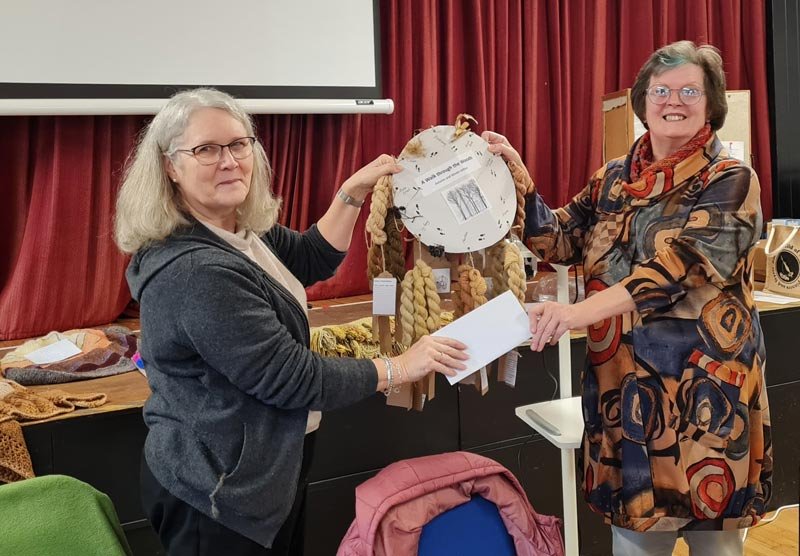
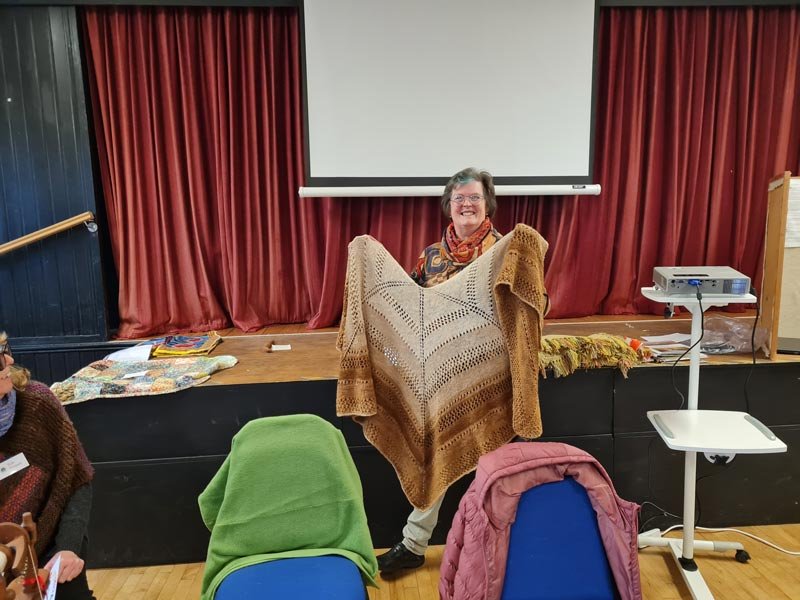
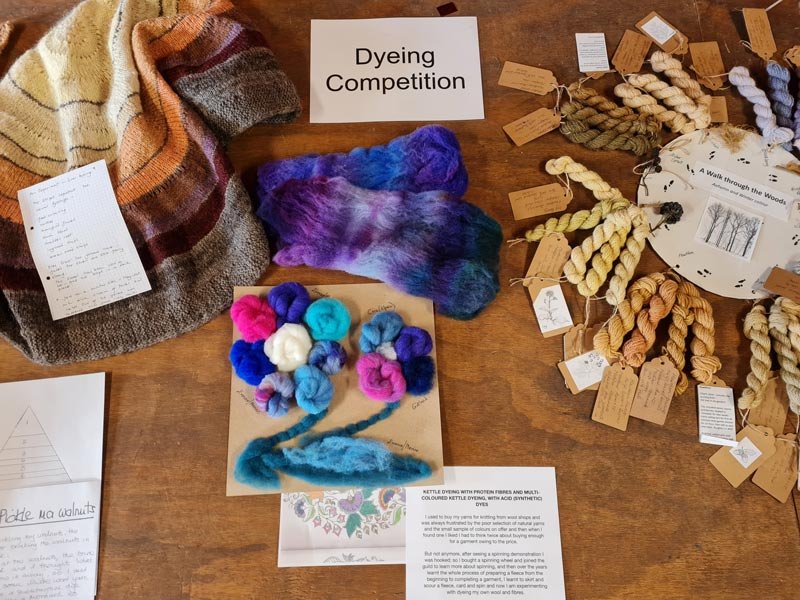
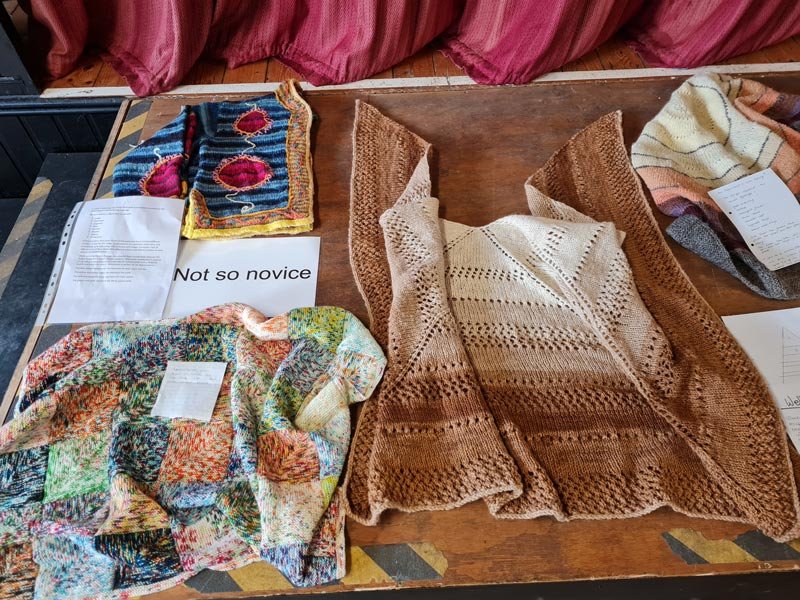
Tea and Coffee Rota
March 16th
10.30 – 12.00 - Anita Darlington & Frances Nicholson
12.00 – 1.45 Pam Mitchell & Lis Lawrence
April 20th
10.30 – 12.00 - Frances Fletcher & Paulette Bjerfeldt
12.00 – 1.45 - Hilary Tudgee & Christine Edmunds
May 18th
10.30 – 12.00 - Lindsey Cooke & Hilary Watts
12.00 – 1.45 Linda Robinso & Janet Maher
June 15th Fleece Fair
10.30 – 12.00 - Debbie Hills & Karen Langford
12.00 – 1.45 Anne Coombs & Kathy Wright
July 20th
10.30 – 12.00 - Carol Mellish & Lia Jenkinson
12.00 – 1.45 - Laura Tyley
September 21st
10.30 – 12.00 - Sue Luty-Wells & Sarah Basham
12.00 – 1.45 - Paulett & Frances Fletcher
October 19th
10.30 – 12.00 - Juliet Johnstone & Liz Pickman
12.00 – 1.45 - Frances Nicholson & Karen Langford
November 16th
10.30 – 12.00 - Brenda Lawrence & Brenda Hamblin
12.00 – 1.45 - Sonia and Ian Waite
January 18th 2025
10.30 – 12.00 - Linda Robinson
12.00 – 1.45 - Frances Parlane
February 15th 2025
10.30 – 12.00 -Thalia Skeath
12.00 – 1.45 - Lyn Blower & Sue Prosser
Reserves: Sue Latimer, Tina Davis
A journey into natural dyeing with Brian Bond
At our January Guild meeting, Brian Bond of Badger Crafts shared his Journey into natural dyeing. Thank you to Sue Latimer for these brilliant notes and photos.
Brian learned to knit as a child then started again when a friend gave him a knitted jumper together with the leftover wool. Next came the wish to learn to make yarn and spin. He joined the local WSD at the same time as Ashley and Susan who started www.naturesrainbow.co.uk. With combined experience in scientific research statistics, biology and chemistry, naturally experiments followed challenging the then current theories of natural dyeing, such as ‘You’ll never get a bright colour with plant dyes’, ‘You never know what you are going to get’, ‘Plant dyes always lose their colour’. The development and reliance of chemical dyes meant that there was no need to keep growing dye plants.
‘The Grande Teintes’ term was used by 17th century French authorities to control the quality of dyes. Light fastness of colours was important, not just the depth of colour. Have you noticed unusual blue areas on old tapestries? Yellow is prone to fading, so the original green for fields and leaves reverts to the more persistent blue.
Blue = Woad or Indigo, Yellow = Weld or Dyers Greenweed, Red = Madder. Most colours could and can made by combinations of these dyes.
Blues can come from
woad, a biennial brassica in Europe or
Japanese Indigo (Persicaria, knotweed), a subtropical annual or
Indigofera tinctoria, a tropical species of the pea family.
Ideally for the best colours, process the leaves on the day of harvest. Heating above 60°C will denature the dye. Slow dye at 25°C (perhaps in a greenhouse) for 72 hours, or down to only 30 mins at 50° C.
Yellows can come from
Weld combined with indigo made Lincoln Green. It grows better in the chalky, drier east of England. It may be found on building sites, rich with limestone / cement, after ground has recently disturbed.
Dyers’ Greenweed combined with blue made Kendal Green. Grows better in the wetter west of England.
Brian used weld to demonstrate a system for his experiments. What can be changed, and how can the effects of each change be measured? Label samples carefully and then reorganise to assess results.
At low levels of alum mordant, the cream of tartar mattered less than it did at higher concentrations of alum. C of T for baking is not so pure, so worth investing in the higher quality from dye suppliers.
Madder comes from different plants around the world, and contains multiple pigments e.g. Alizarin
Rubia tinctoria in Middle East
Rubia peregrina is a wild plant found around the Mediterranean and on SW English coasts
Galium album – hedge bedstraw ) also grow wild but roots are smaller and harder to extract
Galium verum – lady’s bedstraw ) enough dye colour
Asperula tinctoria – Dyers woodruff in Northern Europe and Scandinavia
Annual goosegrass may again yield only thin roots, ‘probably would get pink’
Different dyes emerge from different parts of the root. After three years the roots will be thicker (and 50 cm deeper). The outer layer will yield orange. Red may appear with further extractions of dye.
Bash or cut up madder after the first extraction (when softer) to get to the inner sections.
Fresh probably better than dried but drying the roots, then keeping for 2-3 years gives strong colour.
Powder easy for quicker reds, doesn’t dissolve, will get into the dyestuff. Restrain powder in a bag.
Use fresh water for each dye extraction
Grows mould quicker than for other dyes?
Brian hasn’t tried freezing dyes – a question from the audience
Chalk will brighten the colour but not much
Bright red news flash: do not need to keep dyebath under 60°C. An old recipe revealed that for a bright red, taking the dye up to 95°C for just 5 minutes at the end of extraction will give brighter reds, any longer will yield those browns. (I will be trying this next week!!)
Blue then yellow when overdyeing – it depends?
Indigo can stick to yarn better and may block the yellow dye receptors?
Blue deepens with repeated dip dyeing in indigo, so consider adding blue to a yellow base?
However mordants are acid, which will affect dye colour. Indigo doesn’t need a mordant, so may be better to use indigo first, then apply mordant if needed and then yellow?
Growing tips:
Brian is also enthusiastic about growing his own dye plants. He manages the Schumacher College Natural Dyeing Garden near Totnes. Several of us from the Somerset had an inspiring visit there with the Dorset Guild in August 2023. A similar day is being planned in 2024.
Think whether a dye plant is an annual, biennial or a perennial and choose a site in the garden accordingly to prevent disturbing when harvesting other plants.
Crop rotation, include with vegetable crop rotation
Madder is a perennial but try a three year rotation, digging up a third each year.
Weld and woad both biennial, rosette of leaves in the first year, (flowers) and goes to seed the second year. Woad leaves better dye in the first year, weld better in the second year. Colour may be better if harvested after 2-3 weeks of sunny weather (in Somerset climate???). Can use the whole of weld plant for dye extraction.
Indigo crops very nutrient hungry, other crops need feeding with compost or manure
Consider growing Dyer’s greenweed like a box hedge
Not all varieties of eucalyptus are good for dyeing – think before planting
Could plant dyes replace synthetic dyes?
To produce present day requirements, an area equivalent to size of Wales would be needed.
Better not to buy so many clothes and reduce demand on synthetic dyes!
Take home messages:
Don’t believe everything that you read in books
Understand the chemistry
Interrogate the process
Be systematic
Check reproducibility
Rotate your growing
Cultivate not forage – don’t deplete population of that plant, or will impact on its ecosytem
Brian kindly judged the Somerset Guild Dyeing competition, on the theme of nature. He was very complementary about the level of information provided by the entrants. You can read more about this in the Guild competition section.
I did also take notes on the science of dyeing – ask me if you are interested to see these.
Sue Latimer
The Guild’s AGM and an introduction to the world of kilt-making with Paul Henry from Fleece to Pleats.
Our February meeting was a busy one! The Guild’s annual general meeting was held in the morning. We welcomed our new chair and committee meetings. If you’d like detailed minutes, please contact secretary@somersetguildwsd.org.uk.
Afterwards, Paul Henry from Fleece to Pleats shared an introduction to the world of kilt-making.
Paul shared his journey from starting to sew at 8 years old with his mother, to collecting over 100 drop spindles, to making kilts in the traditional style containing about 8 yards of worsted fabric with knife pleats! His story kicked off with an introduction to the world of wool, spinning, weaving, dyeing, and moved on to tartan, and kilt-making. It was a brilliant historical overview of the development of weaving and the history of tartan, finishing with a “show and tell” of how a kilt is made.
Paul shared how he has worked with primary schools in East London, where he talks and demonstrates spinning flax and shows the students how to spin with simple drop spindles. Some of these schools are now growing and processing flax on school grounds!
Paul showed us lots of examples and samples; he explained that once upon a time the wearing of kilts was seen as almost exclusively Scottish, those days have passed, and now kilt wearers are found all over the world from lots of nationalities. The origin of the kilt is somewhat of a mystery, but there is documented evidence of its existence from the last few years of the seventeenth century. It’s likely that they were made from local woollen cloth, in whatever shade or pattern the local weaver was able to supply. Over the course of time, patterns and colours became identified with regions or family names.
Today anyone can wear a kilt, in almost any pattern or tartan, there are virtually no restrictions, although many still choose a clan-based tartan. There are thousands of tartans to choose from, hundreds of tweeds and probably millions of other fabrics which would make wonderful kilts.
Paul makes kilts in the traditional style containing about 8 yards of worsted fabric with knife pleats, and also contemporary kilts containing between 5 to 6 yards usually of denim or cotton but increasingly of tweed. Each kilt is made to order - it takes many hours of patient and precise work, averaging around 25 hours to plan, measure, and then hand sew.
News from Association of Guilds of Weavers, Spinners and Dyers
Recent news
The latest edition of the AGWSD News has up-to-the minute information about the AGM, the National Exhibition 2024, and Summer School 2025 as well as new additions to the Speakers List, and Chris Knowles' favourite piece of equipment may surprise you. Click here to read in full
Joining area meetings
If you would like to join any of the South and South West Zoom meetings as a Somerset rep, please get in touch with Janet Maher. These are a great chance to hear about what’s happening at other Guilds.
The AGWSD National Exhibition
The AGWSD organises the National Exhibition every 2 years to showcase the skills and creativity of members of guilds across the UK. The National Exhibition with the theme ‘Borders, Battles, Books' will run from 14th to 27th October 2024. It will be held at Hay Castle in Hay-On-Wye. There are two parts to the exhibition: The first part is for items that are put forward for the selection process. These items may be your own ideas or may be based on this year’s theme. The second part, the non-selected part, is open to any guild member. This year we ask that a removable book cover, on a slimline A5 or A6 notebook, is created to the theme of, ‘Battles, Borders, Books’. Items for all parts of the exhibition must include spinning, or weaving, or dyeing or a combination of these. Other textile techniques may be used as part of the item, though spinning, weaving, dyeing must be the predominant techniques.
For handweavers, handspinners or hand dyers with less than three years’ experience, there is a chance to be awarded the Lylie Smart trophy. The winner is decided by public vote during the exhibition with all visitors being asked to vote for their favourite item from those put forward for the award. Find more information about the AGWSD here.
AGWSD Conference
Have you secured your place at the AGWSD Conference? Named ‘The Riches of Wool’, it will take place on the 12th to the 14th July 2024 at Bicton College, Exeter. If you’re going and happy to liftshare, please email lauratyley1@gmail.com who will coordinate the Somerset Guild road trip!
Fibre and Somerset-focused video
We spotted some familiar faces (both Guild members and local fibre producers) in this beautiful short film highlighting UK-based farmers who are pioneering sustainable material production on home soil.
A new Facebook community group for the Somerset Guild
Unfortunately Facebook removed our thriving community group last year. But we now have a new one! If you would like to join it, you can do so here. This is a place to share fibre-related projects, ideas, and general discussion.
One of the recent posts in the group was from a Somerset-based shepherd with a flock that is a mix of Northern European shorttails. Their main bloodline is Shetland. He has recently brought in a ram who is 75% Romney 25% Shetland. Wool from the flock where he got the ram, has seen micron at 15!
He’s looking for some spinners to spin his wool so he can test what it looks like once it’s woven. If you’d be interested, please contact Theambroseflock@gmail.com
A raffle prize became...
3 fingered tyrannosaurus mittens, more practical than normal mittens or gloves.
This brightly coloured fleece was fractal spun, then crocheted by Vanessa Woodford. Not quite enough for the fingertips so an effective black added. Delighted recipient.
What have you created from a raffle prize? Email photos to lauratyley1@gmail.com and we can include it in the next newsletter!
Upcoming Guild talks and other events
March 16th
A chat with Bethan Murray, a curator of Social History and Textiles at Somerset Heritage Museum.
Marilyn Biggs will be bringing her Dye Work for sale. Mandy Stead will be bringing some wool cones for sale for Guild Funds. These were collected by Georgina Vye on behalf of the Guild.
April 20th
Skills day! Our members will share an array of weaving, spinning and dyeing skills:
Inkle Loom - Sophie Fovargue
Crochet - Pam Mitchell
Weaving loop - Frances Fletcher
Fine Spinning - Pat Ilsley
Art Yarn - Amanda Hannaford
Knitting - Marilyn Biggs
Choosing Fleece - Mandy Stead & Sue Prosser
There will be more information at the March meeting as the Skills will be divided up to am and pm. There will be a sheet covering these skills for members to sign up for their preference.
May 18th: Brigitte Graham will join us for a discussion on Rush Weaving.
June 15th: Our annual fleece fair!
Other events:
Fernhill Fibre Experience - Saturday 16th March
Blade Shearing Tournament at Fernhill - Sunday 17th March
Fernhill Farm’s Good Friday Fleece Sale - March 29th
The Sodbury Yarn Over - 6-7th April, Chipping Sodbury
Wonderwool Wales – 27-28th April in Builth Wells, shared coach with Exeter Guild may be available.
Great British Fibre Festival - 1st & 2nd of June at Coldharbour Mill.
Notices
Equipment
Equipment is being organised by Sue Latimer. A message from Sue about Guild equipment loans. Have you wanted to try weaving on a rigid heddle loom, or spinning on a different wheel, or using the drum carder? Please see this page for details of what is available at the guild.
Ian will continue to look after the deposit and hire payments, but I will check the equipment in and out to try to keep it in good working order, and to give essential instructions as needed.
Ideally to speed up the process, email me a day or two before the meeting when you wish to collect. Is anyone able to help with this? I am looking for a team of two or three others, so that there is cover should I miss a guild meeting. Sue’s email: suelatim@gmail.com.
Car Share
Car share to Guild meetings was raised at the AGM. Please let secretary@somersetguildwsd.org.uk know if you can offer lifts to and from Guild meetings. And anyone who you know who might indeed need a lift, please get in touch.
EnviroFair24
EnvrioFair24, organised by Stoke Environment Group SEG at Stoke St Gregory village on the Somerset Levels, is being held on Saturday 1st June 2024 and they’ve asked us if anyone from the Guild would be happy to organise a stand showing what we do and/or give a demonstration, or perhaps something different that you think would be suitable. Please let Norma - secretary@somersetguildwsd.org.uk - know if you’re interested. The event has a range of speakers, displays and activities all with environmental themes, wildlife, energy and educational information.
Newsletter content
Please send anything you would like included in the next newsletter (June) to lauratyley1@gmail.com.
Fleece Fair
Could you please keep an eye out, and let me know of any publications/notice boards that you find where we can put Event details for free. I've picked up a few local booklets/Art magazines etc, but I need more. Please.
Many thanks Fay - faywilks@gmail.com
Wonderwool
27th and 28th April 2024
The Devon Guild are running the bus from Devon to Wonderwool again this year and wonder if any of your members would like to join us as you are very welcome. The price has increased, sadly, to £55 for the coach and entry fee.
It leaves Bovey Tracy station rd car park. 06.30 and stops at :
Sowton Park and ride junction 30 Exeter 06.50
Tiverton Travelodge junction 27 07.10
Taunton blackbrook Park Rd junction 25. 07.30
Contact me through chair@devonguildwsd.org.uk for any more information.
Items for Sale
If your item is listed below and has now sold, please contact Sue Latimer - suelatim@gmail.com - to have it removed.
If you would like to list an item for sale, please contact Laura Tyley - lauratyley1@gmail.com


